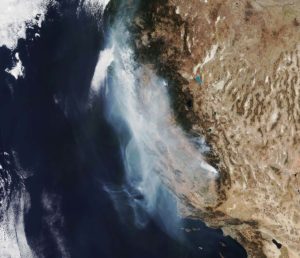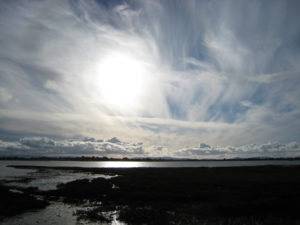I moved to the Bay Area 20 years ago, and still feel a daily thrill at living in such a special place. Today, as I reflect on my new role as CEO of Greenbelt Alliance and the path that brought me here, I am struck by how lucky I am that I can make a living by protecting, preserving, and enhancing the factors that make our region unique. But I also see the challenges our communities are facing and the urgent need for us to come together more effectively as a region and build a more resilient future.
Remember, they are an exotic species in the Western United States, and are rapidly increasing their geographic range and range of habitats. Are they outcompeting or excluding native species in the process? How would we know? We have done almost nothing to monitor changes in the assemblage of mushroom species in areas before and and after the incursion of death caps.
Further Reading
Pringle et al, “The ectomycorrhizal fungus Amanita phalloides was introduced and is expanding its range on the west coast of North America,” Molecular Biology 2009
Lockhart et al, “Simultaneous emergence of multidrug-resistant Candida auris on 3 continents confirmed by whole-genome sequencing and epidemiological analyses,” Clinical Infectious Diseases 2017
Battalani et al, “Aflatoxin B1 contamination in maize in Europe increases due to climate change,” Scientific Reports 2016
The author is the CEO of the Greenbelt Alliance, a regional nonprofit dedicated to smart growth and conservation in the Bay Area. More at Greenbelt.org
My first stint at Greenbelt Alliance, an organization that has helped shape how the Bay Area grows and thrives for over 60 years, began in 2006. At the time, our region was on the cusp of a severe economic downturn. The last generation of housing growth had sprawled out across our former green hills and ranches, and very little new development had happened within the desirable, walkable neighborhoods throughout our cities and towns. Looking back, it’s clear the seeds of our current affordability crisis were sown over those many years, becoming more evident as the economy regained steam throughout this decade.
Still, from today’s vantage point, the world of Bay Area regional planning has made heartening progress over the last decade. Around the region, a wider variety of voices are speaking up for the many values of open space: recreation, climate resilience, wildlife habitat, water quality, and more. Some local leaders and community members are advocating for more homes in their own neighborhoods, prioritizing compact development over sprawl, welcoming new residents to our growing region, and looking for new ways to protect existing residents from displacement.
Yet our regional challenges continue to grow. While more land is permanently protected through policies and acquisition, and the region has invested millions in preservation, restoration, and recreation; housing development has not kept up, and gridlock and lack of infrastructure investment plague quality of life. As we all can see, housing affordability has reached crisis levels—raising serious questions about who gets to live and thrive in this region, and how we ensure vulnerable residents and middle-class families are not pushed out.
On top of these familiar challenges is a new threat. Just 10 years ago the reality of climate change still felt remote. We knew the impacts could be dire and wanted to leave a healthy planet for our children and grandchildren, but we didn’t feel enough urgency to take bold action. Since then, a five-year drought, San José’s unprecedented 2017 flooding, and wildfires have made clear that we can’t choose not to worry about climate-related threats. They have reached our doorstep.
I remain an optimist. While the path forward is hard, our long history of conservation has helped prepare us for the trials we face. By preserving our natural and agricultural lands, past leaders of our region and generations of Greenbelt Alliance activists gave us the natural infrastructure we need to thrive in a future they could never have imagined.
Our rolling hills and valleys aren’t just a stunning natural treasure; they’re an important facet of our urban watersheds, absorbing stormwater to reduce flood risks downstream.
Our local farms and ranches provide more than high-quality local food; a new generation of farmers is turning them into climate science laboratories by experimenting with techniques that reduce water use and store more carbon in the soil.
The urban growth boundaries Greenbelt Alliance has championed for so long now do more than limit sprawl; the crucial buffer they’ve preserved between our forests and our built environments mitigates fire risk to our cities and towns.
These policies give us a strong foundation, but it’s our evolving mindset that gives me the most confidence in our future. Over the last decade, our cities, towns, and counties began to see the Bay Area through a more holistic lens. As a result, we’ve seen a rise in increased regional collaboration and a more balanced valuation of human and natural needs. This understanding shows itself in the compact development increasingly pursued by our cities and towns. Done right, smart infill projects add new parks; they build inviting, walkable streets that foster community connections; they reduce climate impacts and build resilience for the entire region.
Despite these strengths, we’re at a crossroads, and we have a choice to make: What type of Bay Area do we want to build together? As CEO of Greenbelt Alliance, I want to help us adapt to the realities of a changing climate. I want us to build in a way that protects and enhances what makes the Bay Area special—surrounded by protected natural and working lands, where anyone, regardless of their income level, can find a home.
Building that shared perspective, that holistic vision of the interconnectedness of our natural and built environments, is essential to our region’s future. When community stewards across the region stand up together to celebrate and enhance our natural infrastructure and built environment, we’ll truly be able to build towards stronger resilience and a place for all.





